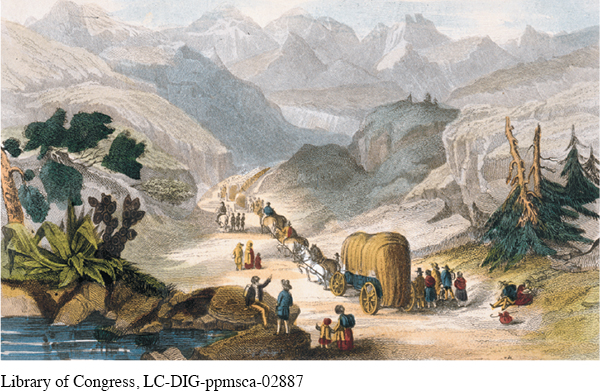Traveling the Overland Trail
In the 1830s a growing number of migrants followed overland trails to the far West. In 1836 Narcissa Whitman and Eliza Spaulding joined a group traveling to the Oregon Territory, the first white women to make the trip. They accompanied their husbands, both Presbyterian ministers, who hoped to convert the region’s Indians. Their letters to friends and co-worshippers back east described the rich lands and needy souls in the Walla Walla valley. Such missives were widely shared and encouraged further migration.
The panic of 1837 also prompted families to head west. Thousands of U.S. migrants and European immigrants sought better economic prospects in Oregon, the Rocky Mountain region, and the eastern plains, while Mormons continued to settle in Salt Lake City. Some pioneers opened trading posts where Indians exchanged goods with Anglo-American settlers or with merchants back east. Small settlements developed around these posts and near the expanding system of U.S. forts that dotted the region.
For many pioneers, the journey on the Oregon Trail began at St. Louis. From there, they traveled by wagon train across the Great Plains and the Rocky Mountains to the Pacific coast. By 1860 some 350,000 Americans had made the journey, claimed land from the Mississippi River to the Pacific, and transformed the United States into an expanding empire.
Explore
See Document 12.1 for one account of the journey west.
Because the journey west required funds for wagons and supplies, most pioneers were of middling status. The majority of pioneers made the three- to six-month journey with family members, to help share the labor. Men, mainly farmers, comprised some 60 percent of these western migrants, but women and children traveled in significant numbers, often alongside relatives or neighbors from back east. Some courageous families headed west alone, but most traveled in wagon trains—from a few wagons to a few dozen—that provided support and security.
Traditional gender roles often broke down on the trail, and even conventional domestic tasks posed novel problems. Women had to cook unfamiliar food over open fires in all kinds of weather and with only a few pots and utensils. They washed laundry in rivers or streams and on the plains hauled water from great distances. Wood, too, was scarce on the plains, and women and children gathered buffalo dung (called “chips”) for fuel. Men frequently had to gather food rather than hunt and fish, or they had to learn to catch strange (and sometimes dangerous) animals, such as jack rabbits and rattlesnakes. Few men were prepared for the dangerous work of floating wagons across rivers. Nor were many of them expert in shoeing horses or fixing wagon wheels, tasks that were performed by skilled artisans at home.

Expectations changed dramatically when men took ill or died. Then wives often drove the wagon, gathered or hunted for food, and learned to repair axles and other wagon parts. When large numbers of men were injured or ill, women might serve as scouts and guides or pick up guns to defend wagons under attack by Indians or wild animals. Yet despite their growing burdens, pioneer women gained little power over decision making. Moreover, the addition of men’s jobs to women’s responsibilities was rarely reciprocated. Few men cooked, did laundry, or cared for children on the trail.
In one area, however, relative equality reigned. Men and women were equally susceptible to disease, injury, and death during the journey. Accidents, gunshot wounds, drownings, broken bones, and infections affected people on every wagon train. Some groups were struck as well by deadly epidemics of measles or cholera. In addition, about 20 percent of women on the overland trail became pregnant, which posed even greater dangers than usual given the lack of medical services and sanitation. About the same percentage of women lost children or spouses on the trip west. Overall, about one in ten to fifteen migrants died on the western journey.
Exploring American HistoriesPrinted Page 384
Exploring American Histories Value EditionPrinted Page 284
Chapter Timeline